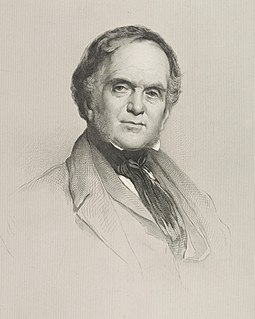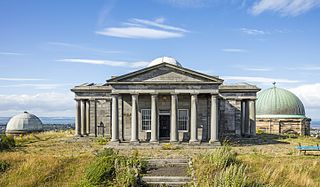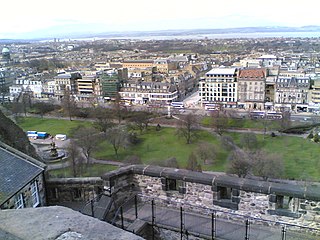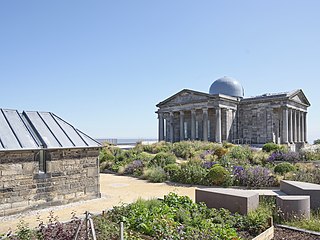
Regent's Park is one of the Royal Parks of London. It occupies high ground in north-west Inner London, administratively split between the City of Westminster and the Borough of Camden. In addition to its large central parkland and ornamental lake, it contains various structures and organizations both public and private, generally on its periphery, including Regent's University and London Zoo.

William Henry PlayfairFRSE was a prominent Scottish architect in the 19th century, who designed the Eastern, or Third, New Town and many of Edinburgh's neoclassical landmarks.

The National Monument of Scotland, on Calton Hill in Edinburgh, is Scotland's national memorial to the Scottish soldiers and sailors who died fighting in the Napoleonic Wars. It was intended, according to the inscription, to be "A Memorial of the Past and Incentive to the Future Heroism of the Men of Scotland".

Calton Hill is a hill in central Edinburgh, Scotland, situated beyond the east end of Princes Street and included in the city's UNESCO World Heritage Site. Views of, and from, the hill are often used in photographs and paintings of the city.

The City Observatory was an astronomical observatory on Calton Hill in Edinburgh, Scotland. It is also known as the Calton Hill Observatory.

The Carlton Gardens is a World Heritage Site located on the northeastern edge of the Central Business District in the suburb of Carlton, in Melbourne, Australia. A popular picnic and barbecue area, the heritage-listed Carlton Gardens are home to an array of wildlife, including brushtail possums.

The New Town is a central area of Edinburgh, the capital of Scotland. It was built in stages between 1767 and around 1850, and retains much of its original neo-classical and Georgian period architecture. Its best known street is Princes Street, facing Edinburgh Castle and the Old Town across the geological depression of the former Nor Loch. Together with the Old Town, and West End, the New Town was designated a UNESCO World Heritage Site in 1995. The area is also famed for the New Town Gardens, a heritage designation since March 2001.

Abbeyhill is an area of Edinburgh, the capital of Scotland.

The Mound is an artificial slope in central Edinburgh, Scotland, which connects Edinburgh's New and Old Towns. It was formed by dumping around 1,501,000 cartloads of earth excavated from the foundations of the New Town into Nor Loch which was drained in 1765 and forms today's Princes Street Gardens.
Edinburgh, the capital of Scotland, is traditionally said to have been "built on Seven Hills", in an allusion to the seven hills of Rome. While there is considerable room for debate as to which hills are included and excluded from the seven, seven possibilities are listed in an old rhyme:

The Dugald Stewart Monument is a memorial to the Scottish philosopher Dugald Stewart (1753–1828). It is situated on Calton Hill overlooking the city of Edinburgh and was designed by Scottish architect William Henry Playfair.

Regent Bridge is a road bridge in Edinburgh, Scotland, where the A1 road enters the New Town from the east and passes over a hollow near Calton Hill. The bridge was built in the 19th century, in the neoclassical style as the medieval city was modernised and expanded to the north and east.

Regent Terrace is a residential street of 34 classical 3-bay townhouses built on the upper south side of Calton Hill in the city of Edinburgh, Scotland. Regent Terrace is within the Edinburgh New and Old Town UNESCO World Heritage Site inscribed in 1995.

The Regent, Royal and Carlton Terrace Gardens are private communal gardens in the New Town area of Edinburgh, EH7. They lie over a 4.8-hectare (12-acre) site on the east side of Calton Hill. The gardens have been listed on the Inventory of Gardens and Designed Landscapes as part of the New Town gardens heritage designation since March 2001. The gardens form some of the collection of New Town Gardens.

Royal Terrace is a grand street in the city of Edinburgh, Scotland, on the north side of Calton Hill within the New Town and part of the UNESCO World Heritage Site inscribed in 1995, built on the south side of a setted street, facing the sloping banks of London Road Gardens, formerly Royal Terrace Gardens, with views looking north towards Leith and the Firth of Forth.

Carlton Terrace is a residential street in Edinburgh, Scotland. It is located on the east side of Calton Hill, at the eastern extremity of the New Town, part of the UNESCO World Heritage Site inscribed in 1995.

The following outline is provided as an overview of and topical guide to Edinburgh:
Bellevue is a district of Edinburgh, the capital of Scotland. It lies to the south east of Canonmills, west of Leith Walk and south of Leith, incorporating the easternmost extent of Edinburgh's New Town UNESCO heritage site. The area was formerly open fields which became the second and penultimate location of the Royal Botanic Garden in 1763 .

Collective is a contemporary art centre in Edinburgh, Scotland, created in 1984. It is situated on Calton Hill, in the former City Observatory and City Dome site. It offers a programme of exhibitions, guided walking tours, audio walking tours, and events.


















